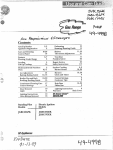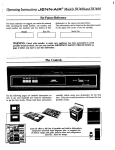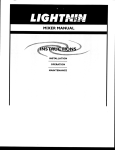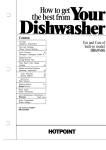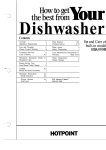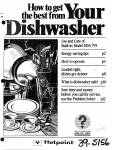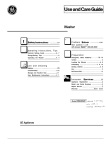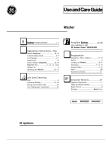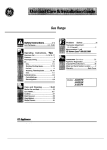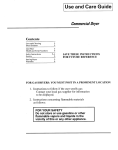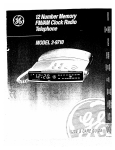Download Hotpoint HDA477K Dishwasher User Manual
Transcript
‘o
Dishwasher
Contenfi
Air Gap
Appliance Registration
11
2
Care and Cleaning
China, Crystal, Sterling
11
10
4
Cycle Features
Detergent, Detergent Guide 6, 7
—
“o
Dispenser Cups
Door Latch
7
4
Energy-Saving Tips
Front Panel Color Change
2
11
Loading
Model and Serial Numbers
8,9
2
Operating Guide
Cycle Selection
4,5
5
Drying Options
Soil Level
4
7
Plate Warmer
Problem Solver
Repair Service
Rinse Agent
5
12-14
15
6
3
Safety Instructions
User Maintenance Instructions 11
Warranty
Water Temperature
Winter Storage
GE Answer Center”
800.626.2000
—
“r>
(
Back Cover
6
11
Use and Care of
built-in models
HDA467L
HDA467K
HDA477K
HDA497K
Enemy-saving tips
Help us help you...
Before xyourdishwher,
read this book carefully.
Write down the model and
serial numbers.
It is intended to help you operate
and maintain your new dishwasher
properly.
You’ll find them on a label fastened
to the tub wall just inside the
dishwasher door.
These numbers are also on the
Consumer Product Ownership
Registration Card that comes with
your dishwasher. Before sending
in this card, please write these
numbers here:
Keep it handy for answers to your
questions.
If you don’t understand something
or need more help, write (include
your phone number):
Consumer Affairs
Hotpoint
Appliance Park
Louisville, KY 40225
Model Number
Serial Number
Use these numbers in any
correspondence or service calls
concerning your dishwasher.
If you received
a &mWed dishwasher . . .
Immediately contact the dealer (or
budder) that sold you the dishwasher.
Save time and money.
Before you M for service...
Check the Problem Solver (pages
12-14). It lists causes of minor
operating problems that you can
correct yourself.
2
The power consumption of your
dishwasher can be minimized if
you follow these suggestions:
● Operate dishwasher only when
full. Let dishes accumulate in
dishwasher. When you put in a
partial load, use RINSE HOLD
cycle to rinse off heavy soils. Be
sure to latch door when waiting for
full load. This helps keep soils
moist, easier to remove.
● Select cycle that uses least
amount of water to remove soil
from load. See pages 4 and 5.
● If you don’t need your dishes
right away, use your Drying Heat
OFF feature that turns the drying
heater off automatically and saves
energy. Dishes dry naturally over a
longer period such as overnight.
W~G–~en using this
appliance, always exercise basic
safety precautions, including the
following:
● Use this appliance ody for
its intended purpose, as you
ti fmd described in this Use
and Care Book.
. ~~ ~hw~her must ~
properly instiled and located
in accordance with the
WtaUation htmctions before
it is used. If you did not receive
—
an Instigation Instructions sheet
with your dishwasher, you can
obtain one by contacting the
service location nearest you.
–This appliance must be
connected to a grounded meti,
permanent wiring system; or an
equipment-grounding conductor
must be run with the circuit
conductors and connected to the
equipment-grounding terminal
or lead of the appliance.
—Connwt to a properly rated,
pro&cted and stied power-supply
circuit to avoid elextricd overload.
● Use otiy powder or liquid
detergents or wetting agents
recommended for use in a
dishwasher.
● DO not wash plastic items udess
marked “dishwasher safe” or the
equivalent. For plastic items not so
marked, check the manufacturer’s
recommendations.
Q Load light plastic items so
they WW not become dislodged
and drop to the bottom of the
dishwasher-they might come
into contact with the heating
unit and be darnagd.
To minkniu the possib~ty of
~ury.
● Men loading items tO k
washed:
A. kate sharp items so that
they are not likely to damage
the door serd, and
B. had sharp knives with the
handes up to reduce the risk
of cut-type injuries.
● Do not touch the heating
element during or immediately
after use.
● Do not operate your dishwasher
udess dl enclosure panels are
properly in place.
●
Do not tamper with controls.
● Do not abuse, sit on, or stand
on the door or dish rack of the
dishwasher.
● Close supervision is necessary
if this appliance is used by or near
c~dren. Do not allow ctidren
to play inside, on or with this
appliance or any discarded
appliance. Dispose of discarded
appliances and shipping or
packing materird properly.
Before discarding a dishwasher,
remove the door of the wshing
compartment.
3
bp ~ washing detergents
and wetting agents out of tie
reach of cMdren, prekrably in
a locked cabinet. Observe W
warnings on container labels to
avoid persoti injury.
●
●
~ROG~ GM is
produced @ the chemical action
within your water heater. It can
accumulate in the water heater
and/or water pipes if hot water
has not been used for a period of
two weeks or longer. ~R~EN
OASIS EXPLOSWE. To prevent
the possibility of damage or
injury, if you have not used hot
water fir two weeks or more, or
move into a residence in which
the hot water system may not
have been used for some time,
turn on dl hot water tiucets and
Wow them to run for seved
minutes before using any
electricrd appliance which is
connected to the hot water
system. This WW ~ow any
hydrogen gas to escape. Aso,
since the gas is flammable, do
not smoke or use an open flame
or appliance during this process.
mSTRUCTIONS
How to operate your dishwasher
Door Latch
(Locked)
Cycle Indicator Dial
(Turn to Start)
(
{
~lm
::
L
STEP 1. Load your dishwasher
with dishes, silverware, pots, pans,
bowls, etc. according to
instructions on pages 8 and 9.
STEP 2. Add detergent to the
detergent dispenser. Make sure the
Cycle Indicator Dial is at OFF
position before adding detergent.
See pages 6 and 7.
Use rinse aid agent to help prevent
spotting. See page 6.
STEP 3. Select DRYING HEAT
Option. It must be ON for PLATE
WARMER cycle, OFF for RINSE
HOLD cycle. It can be ON or OFF,
at your option (see below), for any
of the wash cycles.
DRYING
HEAT OFF
DRYING
HEAT ON
u
DRYING HEAT ON. Turns the
drying heater on for fast drying.
DRYING HEAT OFF. ~rns the
drying heater off to save energy.
Dishes will dry naturally over a
longer period such as overnight.
If you need your dishes sooner,
open the dishwasher door afier the
cycle is complete to reduce the
natural drying time.
Use of this option reduces the
electrical energy used by this
model approximately 10% for
the NORMAL WASH cycle.
STEP 4. Select the Cycle and start
dishwasher.
If your dishwasher drains into a
food waste disposer, operate the
disposer until it is empty before
starting the dishwasher. (See Cycle
selection hints on next page. )
To obtain the benefits of a comDlete
cycle, be careful that you do n;t
turn the dial any further than
necessary to start the dishwasher.
●
For NORMAL WASH cycle:
a. Latch the door.
, RINSE ::f~~
HOLO .,., E
8
@
PLATE WARMER
■ SELE~ORYINGHEA1a
b. Slowly turn Cycle Indicator Dial
to ON position to start the cycle.
There is a time delay between
start-up and water fill so you will
not hear any wash action right
away.
4
●
For LIGHT WASH cycle:
a. Be sure door is unlatched.
b. Slowly turn Cycle Indicator Dial
to LIGHT WASH position.
c. Latch door to start the cycle.
●
LIGHT WASH ■
ON W
OFF ■
“G”T;’@
..::::: B
For RINSE HOLD cycle:
a. Be sure door is unlatched.
b. Select DRYING HEAT–OFF
drying option.
LIOHTWASH ■
ON ■
OFF ■
■
, RINSE ::::.:
HOLO .,., =
@
PLATE WARMER
■ s, LE~O.YINGHEAT%
c. Slowly turn Cycle Indicator
Dial to RINSE HOLD position.
d. Latch door to start the cycle.
●
Cycle selection hints
For PLATE WARMER cycle:
It is important to follow the loading
instructions on pages 8 and 9.
a. Load clean plates and dishes to
be warmed.
b. Select DRYING HEAT–ON
drying option.
c. have the door unlatched.
NORMAL WASH—For most
loads of everyday dishes, glasses
and cookware with medium soils.
LIGHT WASH–For dishes
that have been pre-rinsed before
loading. Also, for washing very
lightly soiled dishes with soils
that have not dried on.
LIGHT WASH ON m
OFF 8
. ~,N~E SELECT
HOLO
H:::’&F
#
RINSE HOLD—For rinsing
partial loads which will be washed
later. Select DRYING HEAT–
OFF drying option. Do not use
detergent.
PLATE WARMER—For warming
clean dishes and serving plates for
the serving of hot food. -
@
PLATE WARMER
■ SfLE~OR”lNOHEAT~
I
I
d. Slowly turn Cycle Indicator Dial
clockwise to PLATE WARMER
position.
e. Latch the door to start the qcle.
What happens in each cycle
wash
(approx.)
minutes)
Cycle Sequence
10.7
,,*
~lFl~lFIFIF]
LIGHT WASH
8.9
51
RINSE HOLD
5.1
15
Cycl=
NO~AL WASH
You’ll hear occasional clicking
sounds:
–Soft food disposer shredding
action.
—Drain valve opening to pump
water out.
—Timer control as cycle
progresses.
—Detergent cup opening.
●
Wash
Water Use Cycle Time
Gallons
(approx.
mHBBE
EBB
*DRYING HEAT—ON: Add 28 minutes.
c During the drying period:
—The motor stops.
—Water vapor is released through
the vent under the door handle.
It maybe visible.
5
@od dishwashing stirb
with H~ water.
To get dishes clean and dry you
need hot water. To help you get
water of the proper temperature,
your dishwasher automatically
heats the water in the wash cycle.
For good washing and drying, the
entering water must beat least
120°F. To prevent dish damage,
inlet water should not exceed 150°F.
How to test water temperature:
Check the water temperature
inside your dishwasher with a
candy or meat thermometer.
Let the dishwasher run through
one fill and pump out cycle, then
let the dishwasher fill with water
the second time.
When you hear the water stop
filling, unlatch the door and slowly
open it.
Measure the temperature of the
water in the bottom of the tub this
way:
laundry or run hot water for
showers, give your water heater
time to recover before operating the
dishwasher.
To improve washability if the water
is less than 120°F and you cannot
adjust your water heater: Select a
longer cycle and fill both detergent
cups at least half-full with detergent.
Help prevent spotting
with a rinse agent.
A rinse agent makes water flow off
dishes quicker than usual. This
lessens water spotting and makes
drying faster, too.
For best dishwashing performance,
use of a rinse agent such as JET-DRY
brand is recommended.
Rinse agents come in either liquid
or solid form. Your dishwasher
uses the solid form.
If you can’t find any rinse agent,
write:
BENCKISER CONSUMER
PRODU~S, INC.
(“JET DRY”)
411 W. Putnam Ave.
Greenwich, ~ 06830
Remove the silverware basket and
place a candy or meat thermometer
in the water ~owards the middle of
the tub. If the temperature is less
than 120°F, you will not get good
washing results. Higher water
temperature is needed to dissolve
grease and activate powder
detergents.
How to choose and use
the right detergent.
First, use only powder or liquid
detergents specifically made for
use in dishwashers. Other types
will cause oversudsing.
Second, check the phosphate
content. Phosphate helps prevent
hard-water materials from forming
spots or film on your dishes. If your
water is hard (7 grains or more),
your detergent has to work harder.
Detergents with a higher phosphate
level will probably work better. If
the phosphate content is low (8.7%
or less), you’ll have to usc extra
detergent with hard water.
Your water department can tell
you how hard your water is. So
can your county extension agent.
Or your area’s water softener
company. Just call and ask them
how many “grains” of hardness is
in your water.
How much detergent should you
use? That depends. Is your water
“hard” or “soft”? With hard water,
you need extra detergent to get
dishes clean. With soft water, you
need less detergent.
Too much detergent with soft water
not only wastes money, it can be
harmful. It can cause a permanent
cloudiness of glassware, called
“etching.” An outside layer of glass
is etched away! Of course, this takes
some time. But why take a chance
when it’s easy to find out the
hardness of your water.
Keep your detergent fresh and
dry. Under the sink isn’t a good
place to store detergent. Too much
moisture. Don’t put powder detergent
into the dispenser until you’re
ready to wash dishes, either.
(It won’t be fresh OR dry.)
Helpful hints: If outside
temperatures are unusually low, or
if your water travels a long distance
from water heater to dishwasher,
you may need to set your water
heater’s thermostat up. If you have
not used hot water for some time,
the water in the pipes will be cold.
Turn on the hot water faucet at the
sink and allow it to run until the
water is hot. Then start the
dishwasher. If you’ve recently done
If your powder detergent gets old
or lumpy, throw it away. It won’t
wash well. Old detergent often
won’t dissolve.
If you use a liquid dishwasher
detergent, these precautions are not
necessary because liquid detergents
don’t “lump” as they age or come
in contact with water.
6
How to prepare the
dishes for washing
You’ll find two detergent
dispensers on the inside door of
your dishwasher. Two, because
some cycles use two washes.
r
/
/ \\ \ \\ w /
I
If this is your first dishwasher, or
if you’re replacing a much older
model, you may wonder how much
pre-preparation your dishes need.
Actually very little. Pre-rinsing of
normal food soils is not necessary.
With common sense and a little
practice you’ll soon how what
foods to remove. Here are some
guidelines:
1. Scrape off bones, seeds, stins,
I
I
See C’Detergent Usage Guide”
below. (Be sure the Cycle Indicator
Dial is at OFFposition before
adding detergent. Otherwise the
detergent cup will not close and
latch properly.)
toothpicb and other hard solids. It
is also best to remove hard shelled
vegetables, meat trimmings, leafy
vegetables and crusts. Remove
excessive quantities of oil or
grease.
2. Remove large quantities of any
food. Your dishwasher has a built-in
SOR food disposer that pulverizes
soft food bits and flushes them away.
It can handle small amounts of
soft foods, but large amounts will
be difficult to handle.
3. Try to remove food scraps and
place dishes in dishwasher before
soil has a chance to dry and become
hard. Dishes with dried-on soil are
more difficult to wash and may
not come clean in the NORMAL
WASH cycle. Remember to use
your MNSE HOLD cycle for small
“holding” loads.
Note: The foods mentioned above
are for examples only. Other foods
not mentioned may also need to be
removed from your dishes. You may
rdso want to consider removing fds
such as mustard, mayonnaise,
vinegar, lemon juice and other
foods that can cause discoloration
of staidess stil if dlowd to remain
on dishes for a long period of time.
1-
Close the main cup.
N~E: Detergent cup maybe
opened manually with no harm.
Dete~ent Usage Guide (powder or liquid)
I MEDIUM WATER
I SOFT WATER
flCLES
NORMAL WASH cycle
LIGHT WASH cycle
RINSE HOLD cycle
(O-3 grains hardness)
Main Cup
] Open Cup
1 Tablespoon ~ 1 Tablespoon
minimum
minimum
None
1 Tablespoon
minimum
(3-7 grains)
Main Cup
Half Full
Half Full
\ Open Cup
~ Half Full
None
Use no detergent
Use no detergent
*12 grains and up is extremely hard water. A water softener is recommended. Without it,
lime can build up in the water valve. The water valve may stick while open and cause flooding.
~Filled Main Cup holds 3 tablespoons; Filled Open Cup holds 2 tablespoons
7
] HARD WATER
(7-12 grains*)
I Open Cup*
Main Cup+
J ~;l~pletely
Completely
Full
None
~~l~pletely
Use no detergent
How to load the ~PMCK
The top rack is best for glasses, cups and saucers. Cups
and glasses fit best along the sides. This is the place for
dishwasher-safe plastics, too. Make sure small plastic
items are lodged in tightly so they can’t fall onto the
Cdrod” heating unit. Arrange stemware so that it cannot
move easily. Don’t let the glasses touch each other.
fiis is a random mixed load, the most common type you
will have.
Make sure dishes are properly loaded to insure that
water can reach the soiled surfaces. The wash arm in
the bottom sprays water up. The tower that rises in the
center sends water out over the dishes to wash the items
in the upper rack.
IA
I
I
Sauce pans, mixing bowls and other small items may
be placed—face down—in the top rack. The top rack is
handy for all kinds of odd shapes. Be sure the force of
water and detergent can reach soiled surfaces.
WAXH OUT FOR THIS.
The wash tower rises through the center of the bottom
rack during the wash and rinse portions of the cycle.
Don’t block it or load tall things next to it. Also, be
careful not to let a portion of an item such as a pot or
dish handle extend through the bottom rack. This could
block the wash arm and cause poor washing results.
8
How to load the B~~MWCK
,
Fit plates and saucers between the pins. Place items so
that water and detergent from wash arm can reach soiled
surfaces.
d.
Heavily soiled pots, pans and casseroles MUST be
loaded in the bottom rack, facing down. Prop broiler
pans and racks along the edge.
Don’
item
throughbottom
--
Put flatware in the removable basket with handles up to
protect your hands. Mix knives, forks and spoons so
they don’t nest together. Distribute evenly. Small plastic
items, such as measuring spoons and lids from small
containers are not recommended for automatic
dishwashing. If placed in the dishwasher, they should go
in the bottom of silverware basket with silverware on top.
~
fiecaution!
Take out anything that may fall or extend through the
bottom of the basket.
9
I
What you can usually wash safely in your dishwasher.
And what you can’t.
Material
Aluminum
Usually
Safe
YES
China/
Stoneware
YES
Crysti
YES
Non-dishware
items-such
as electronic
ah cleaner
filters, furnace
filwrs, paint
brushes, etc.
Glass
Iron
-r
Pktjcs
NO
YES
NO
NO
YES
Stainless steel
YES
Sterlhg Silver
and SUver
plate
YES
Non-stick
YES
Exceptions (not safe)
Some colored anodi~
Special Instructions
Some darkening or spotting possible. Remove by
dumiaum can Me.
scouring with soap-filled steel wool pads.
Antique, metal-trimmed,
If in doubt, check with the manufacturer. Or test wash
hand-painted or over-the-glaze
patterns fade.
Gold leaf will discolor.
Antique, metal-trimmed or
hand-painted patterns fade.
Gold leaf will discolor.
one piece daily for at least a month. Compare with the
rest of the set.
Load securely to prevent movement.
Check manufacturer’s instructions for your crysd.
Do not wash in dishwasher. Damage to dishwasher
and discoloration or staining of dishwasher may result.
Milk Glass may yellow.
Iron will rust.
Pewter tarnishes.
If it doesn’t say DISHWASHER SAFE, test one piece
before dishwashing an entire set. Wash in top rack ody.
Rinse if not washing immediately. Salty or acid foods
can stain if left on.
Don’t put in same silverware
basket with stainless steel.
Contact between metals can
damage silver.
Don’t wash copper utensils in
the same load. Silver may get a
brown film.
Adhesive usd to attach some
hollow-handle knives can loosen.
Rinse if not washing immediately. Salty or acid foods can
stain if left on. Dry detergent can cause difficult-to-remove
black spots. Place in back section of silverware basket to
avoid exposure to detergent from the detergent cup.
After washing, wipe the non-stick coating area with
vegetable oil to keep it from losing its non-stick quatity.
coatings
~n
NO
Tin can rust.
Wood
NO
Wood can warp, crack or lose
its finish with any type washing.
Fo~et a dish? Here’s when
you can add it.
Add dishes any time during the
RINSE HOLD cycle. With other
wash cycles, you can add dishes
at any time BEFORE the main
detergent wash portion of the cycle.
However, opening the door during
any cycle lessens cleaning power.
So try to load everything at the
beginning.
Here’s how to add a forgotten dish:
1. Push the door latch to the left.
Washing will stop.
10
2. Wait a few seconds until the
water calms. Then open the door.
3. Add dishes you’ve forgotten.
4. Close the door and push the
latch to the far right. When the
door is locked, washing will
continue.
Care and Cleaning
USER MAINTENANCE
INSTRUCTIONS
Built-in dishwashers
often use an air gap.
Keep it clean.
An air gap is a plumbing device.
It protects your dishwasher against
water backing up into it if a drain
clogs. The air gap is not a part of
the dishwasher. And you may not
even have one. Not all plumbing
codes require air gaps.
If you have an air gap, check it
at least once a month. THE AIR
GAP IS NOT PART OF YOUR
DISHWASHER. IT IS NOT
COVERED m YOUR WARRANTY.
The air gap is easy to clean.
With most types, first turn off the
dishwasher, then lift off the chrome
cover. Then unscrew the plastic
cap and check for any build-up
of grit. A toothpick makes
cleaning easy.
Check the air gap any time your
dishwasher isn’t draining well.
To keep your dishwasher
looking good . . .
Clean the control panel with a
lightly dampened cloth. Dry
thoroughly. Do not use abrasives
or sharp objects on the panel.
They can damage it.
Clean the outside with a good
appliance polish wax. The outside
cabinet finish is durable, but it can
scratch. So use no scouring pads,
harsh or gritty cleaners.
Appliance Polish Wax & Cleaner
(Cat. No. WR97X0216) is available
from Hotpoint Appliance Parts
Marts.
The inside usually takes care
of itself. If it should ever need
cleaning, use a mild cleansing
powder. Scouring pads and harsh
cleaners can mar the finish.
How to change color panels (Model HDA497K)
Your dishwasher comes with
reversible and interchangeable
front panels. Both door and access
panels are held in place by the
panel trim. Each side of each panel
is finished in a different color.
Special lA” thick wood inserts can
replace the two metal panels.
Dimensions for M” wood inserts:
Door Panel: 23X”W x 17 fib”H.
Access Panel: 23M’W x 6% “H.
To change color panels:
Other special finishes can be
applied ~o the metal panels to
match your kitchen decor.
1. Take out two screws from door
and two screws from access panel.
Then remove the side trims from
either side of the dishwasher.
How to prepare your
dishwasher for winter
storage.
If the dishwasher is to be left unused
in an unheated location during the
winter months, have a service
technician take the following steps
to prevent the machine from freezing:
● Remove fuses or trip circuit
breakers to remove electric power
from the dishwasher.
● Turn off water to dishwasher.
Disconnect the water inlet 1 ine
from the water valve and drain.
● Remove water valve from the
dishwasher and blow on small
plastic outlet to remove water.
Replace water valve and water line.
● Remove plug in bottom of rubber
boot and drain completely. Replace
the plug.
::....
,.,
:.,.
. .,
.,:..:.,
;<3
~’
Note: Do not operate dishwasher
while changing panels or when
lower access panel is removed.
&/-
.:,.: .,:. :.:.:.,,:,. , ,i:: :
. :.: .: : :;
::::l:
.,.
j
;
2. Slide out the panels and
replace them with the color you
want in front.
3. Replace the side trims.
11
A:
m
~
Questions?
~
- Use This Problem Solver
PROBLEM
POSSIBLE CAUSE AND REMEDY
DISHWASHER
WON’T RUN
A fise in your home may be blown, or the circuit breaker tripWd. Replace fuse or
reset circuit breaker. Remove any other appliances from the circuit.
UNUSUAL NOISE
Utensils may not be sectlre on rack pins. Or something small may have dropped from
the rack. Water is causing utensils to rattle. Make sure everything is securely placed
in dishwasher.
DISHES DON’T DRY
Make sure inlet water temperature is corrwt. (See page 6.)
Unload the bottom rack first. Water from dishes in the top rack maybe spilling into tl
bottom rack.
Check for improper loading. Dishes shouldn’t nest together. Avoid overloading.
UNCLEAN DISHES
AND FLAWARE
Check inlet water tem~rature. it should beat least 120°F. (To test, seepage 6.)
To obmin the benefits of a complete qcle, be carefil that you do not turn the dial an
firther than necessary to start the dishwasher.
Water pressure may be temporarily low. Turn on a faucet. Is water coming out slower
than usual? If so, wait until pressure is normal before using your dishwasher.
Plugged air gap. (See page 11.)
Improper rack loading. (See pages 8 and 9.)
BMK OR GRAY
MARKS ON DISHES
Aluminum d~sifi often leave marks when they rub against other things. Remove
marks with a mild abrasive cleanser.
DETERGENT LEFT
IN DISPENSER CUPS
Water may not be reaching the detergent cups. Move dishes that maybe blocking
detergent cup.
The dispenser cover may not be opening or may be blocked by improperly loaded
items. If you used a powder detergent, open the cup and remove any caked-on
d~~ertt. If the cup still doesn’t open automatically, cdl for service.
De&qent maybe old. If the powder detergent is hard or caked in the box, throw it aws
The detergent may not be working well. Try another brand.
12
-PROR1,RM
---———- -
POSSIBLE CAUSE AND RE~DY
DETERGENT CUP
WON’T LA~H
AFTER ADDING
DETERGENT
Cycle Indicator did must be in OFF position for cup to latch properly. If you unlatch
the door and open it to dry your dishes, the Cycle Indicator does not advance to
OFF by itself.
SP~S AND FILMING
ON GLASSES AND
FLATWARE
Spotting can be caused by dl these things:
c Extremely hard water. (Seepage 6.)
● Low inlet water temperature. (To test, seepage 6.)
● Overloading the dishwasher.
● hpro~r loading. (Seepages 8 and 9.)
Old or damp powder detergent.
● Phosphate level in detergent too low. (Seepage 6.)
● Too little detergent. (Seepage 7.)
Due to varying local water conditions and personal preferences, try several brands of
detergents to find one that gives the best results for you. A liquid dishwasher detergent
may help reduce filming.
To remove severe spo@ and fflm from glasswre:
1. Remove dl mew utensils from the dishwasher.
2. Do not add detergent.
3. Select NORMAL WASH cycle.
4. Start the dishwasher and allow to run for U to 20 minutes. The dishwasher will now
be in the main wash.
5. Then open the door and pour 2 cups (500d) of white vinegar into the bottom of
the dishwasher.
6. Close the door and allow to complete the cycle.
If vinegar rinse doesn’t work: ReWat as above, except use 1/4 cup (60d) of citric
acid crystis instead of vinegar. (Most drug stores carry citric acid crystis. If yours
doesn’t, cdl Hotpoint Factory Service.)
Using a vinegar or citric acid crysti rinse more than twice a month? Consider a home
water softener,
●
—
—
CLOUDINESS ON
GLASSWARE
If vinegar or citric acid crysti rinse doesn’t work, the cloudiness is “etchingt’ The film
cannot be removed.
It can be prevented: Useless detergent if you have sofi water. Wash glassware in the
shortest cycle that will get them clean.
Water temperature entering dishwasher exceeds UO°F.
YELLOW OR BROWN
FILM
Tea or coffee can stain cups. Remove the stains by hand, using a solution of 1/2 cup
bleach and 3 cups warm water.
An overall yellow or brown film on dishes or glassware can be caused by iron deposifi
in water. A special falter in the water supply line is the ody way to correct this problem.
Your water softener company can tell you about the filter.
Yellow film on sterling silver results when you wash copper utensils in the same load.
Silver polish will usually remove this stain.
(continued on nmtpage)
13
The Problem Solver (continued)
PROBLEM
POSSIBLE CAUSE AND REMEDY
CHIPPING OF CH~A
_ h- cm ~~m cM~@, Load with are. Make sure glassware and china are
swum md ~’t jw leow. (~ pages 8 & 9 for mm way to load glassware.) Make sure
til glases d *- ~ clear the ~ of the tub when you push the rack into the
dishwasher.
Always use the top wk for deticate items.
SMALL AMOUNT OF
Water arouti the oudet on the tub bottom at the back of the ~b is normal. It is clean
water. It’s them @keep tie water ~ lubricated.
WATER STANDING
IN THE BOTTOM
OF THE TUB
WATER WON’T PUMP
OUT OF THE TUB
If the entire tim of~e mb has water, you may hwe a drain problem. Clean the air gap,
if you b OM. u.)
Check the H@hen shk. Is it W* WOH? You may need a plumber.
If dishwasher- into dis~ser, run disposer to clear. Ee sure disposer is not clo~ed.
SUDS IN THE TUB
Stis@*~en@ ~~ot -t for dishwashers, USE ONLY AU~MATIC
DISW~MR DE~RQE~ ~ AW~ SUDS~G.
~ remove suds- the tub: Open ~e dishwasher. Let suds enporate. Add 1 gallon of
cold water to the tub. Close and la&h the dishwasher. Pump out water by slowly turning
the control U wti a M period is reached.
~peat ifnecesw.
DIS~ASHER LEAKS
Suds can caum u~t to ovefiw. That’s why it’s so irnpotit to use a detergent that’s
designed for au@tic dishwashers.
If you need more help.. call, toll free:
GE Answer Center@
800.6262000
consumer information service
14
If You Need Service
—
To obtain service, see your warranty
on the back page of this book.
We’re proud of our service and
want you to be pleased. If for some
reason you are not happy with the
service you receive, here are three
steps to follow for further help.
FIRST, contact the people who
—.
serviced your appliance. Explain
why you are not pleased. In most
cases, this will solve the problem.
NEXT, if you are still not pleased,
write all the details-including
your phone number—to:
Manager, Consumer Relations
Hotpoint
Appliance Park
Louisville, Kentucky 40225
FINALLY, if your problem is still
not resolved, write:
Major Appliance
Consumer Action Panel
20 North Wacker Drive
Chicago, Illinois 60606
15
r
YOUR HOTPOINT DISHWASHER
WARRANTY
Save proof of original purchase date such as your sales slip or cancelled check to establish warranty period.
WHAT IS COVERED
FULL ONE-YEAR WARRANTY
For one year from date of original
purchase, we will provide, free of
charge, parts and service labor
in your home to repair or replace
any part of the dishwasher that
fails because of a manufacturing
defect.
This warranty is extended to
the original purchaser and any
succeeding owner for products
purchased for ordinary home use
in the 48 mainland states, Hawaii
and Washington, D.C. In Alaska the
warranty is the same except that it is
LIMITED because you must pay to
shiD the ~roduct to the service shoD
or ~or the service technician’s travel
costs to your home.
All warranty service will be provided
by our Factory Service Centers or
by our authorized Customer Care(o
servicers during normal working
hours.
Look in the White or Yellow Pages
of your telephone directory for
HOTPOINT FACTORY SERVICE,
GENERAL ELECTRIC-HOTPOINT
FACTORY SERVICE or HOTPOINT
CUSTOMER CARE@ SERVICE.
WHAT IS NOT COVERED
● Service trips to your home to
teach you how to use the product.
Read your Use and Care material.
If you then have any questions
about operating the product,
please contact your dealer or our
Consumer Affairs office at the
address below, or call, toll free:
GE Answer CenteF
800.626,2000
consumer information service
●
Improper installation.
If you have an installation problem,
contact your dealer or installer.
You are responsible for providing
adequate electrical, plumbing and
other connecting facilities.
c Replacement of house fuses or
resetting of circuit breakers.
● Cleaning or servicing of air gap
device in drain line.
● Failure of the product if it is used
for other than its intended purpose
or used commercially.
. Damage to product caused
by accident, fire, floods or acts
of God.
WARRANTOR IS NOT RESPONSIBLE
FOR CONSEQUENTIAL DAMAGES.
Some states do not allow the exclusion or limitation of incidental or consequential damages, so the above limitation or exclusion
may not apply to you, This warranty gives you specific legal rights, and you may also have other rights which vary from state to state.
To know what your legal rights are in your state, consult your local or state consumer affairs office or your state’s Attorney General.
Warrantor: General Electric Company
If further help is needed concerning this warranty, write:
Manager—Consumer Affairs, GE Appliances, Louisville, KY 40225
Pati No. 165 D308OP1O7
Pub No. 39-5194
&89
~lm
HDA467L
HDA467K
HDA477K
HDA497K
















